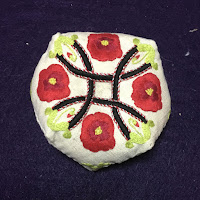
Summer got very busy this year building gardens and getting set up in my new location. I have some time to get back to work now and would like to start by getting this one finished. I'm done more than I'll show you today but I have taken pictures all the way along so there will be more to come later.
I started this piece in the spring inspired by the view from my window challenge put on by the San Francisco School of Needlework At first I didn't even really think I had much of a view out my window just some walls and fences. When I took a closer look at what was over the fence I could see an old style house back under the trees with old tools lined up along the edge of it. With a little less fence and some more of the trees and sky it did make a nice subject for a landscape scene.
I took a bunch of pictures first then made a sketch based on the pictures. I scanned the sketch onto the computer to crop and size. Then darkened all the lines for a print out that could be traced on a light board. I have had better success this way. I've tried tracing pictures off the computer monitor but ran into a few problems with the work sliding around too much. A tablet makes it much easier than a laptop or desktop computer. The work can be held around the back with masking tape and it can be moved around to a better position for drawing. I've found it useful sometimes for small simple designs that can be traced quickly. Designs that take longer to copy can get in the way of using the computer for anything else until the tracing is done. Depending how long it takes this can get very annoying.
I selected a range of colors for the picture. I will not be using all of these. I wanted to narrow my choices and still have extra colors to choose from. Some may look a bit different when I try them in the embroidery.
I started with the black lines first using a split stitch. Many of the lines went almost straight across the piece making good base lines to work from and outlining some large areas making them easy to fill in. I am not going to outline the whole picture in black it would get messy once I got to the trees. The black lines are spaces between the boards that appear black in the picture.
I moved on to adding color with an outline around the brown fence. This outlined will make the top and sides of the boards stand out when the fence is filled in.
















































